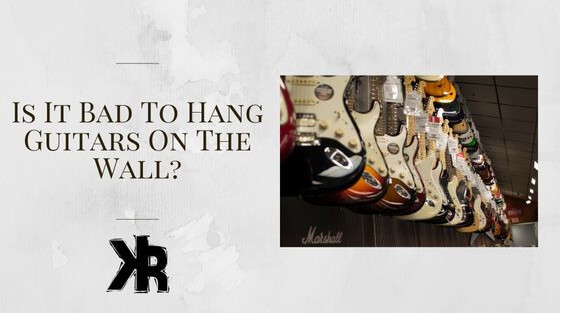Table of Contents
There is a lot of debate on whether it’s bad to hang guitars on the wall. Some people believe that it can damage the instrument.
While others maintain that it’s perfectly safe to do so as long as certain precautions are taken. But is it bad to hang guitars on the wall? Can it damage my instrument?
It’s perfectly fine to hang guitars on the wall. But only if the hangers have been fastened to the wall studs. The room humidity levels need to be in the recommended range as well. You also want to make sure to put them in a place where they will not get knocked off the wall.
In this Killer Rig article, we will provide you with some tips on how to hang your guitars safely. And also keep them in great condition!
Disadvantages of Hanging a Guitar on the Wall
Let’s look at some potential disadvantages. Before we get into the ideal ways of hanging your guitar from the wall. When you know what you are up against, you are more likely to prevent bad things from happening. A few disadvantages to hanging a guitar on the wall include:
- A poorly installed hanger coming free from the wall.
- Humidity levels out of the suggested range within the room.
- Impact damage.
- Fall damage.
- Earthquake or natural disaster damage.
Many of these potential issues are preventable with the proper installation and planning. And most professional luthiers would agree. Let’s look at these a bit more in-depth.
Hanger Coming Off the Wall
When a guitar hanger comes free from the wall, it can cause a lot of damage to the instrument. This is because it was never fastened to a wall stud.
Most electric guitars are somewhat heavy, so without the added support, the weight can cause the hanger to pull away from the wall. Potentially leading to falls or even worse, damage!
To prevent this, you must make sure that the hangers are properly installed. They must be fastened to wall studs. This will provide added support and ensure that your guitar is safe from harm. We will look at the steps on how to do this properly a bit later in the article.
Humidity Levels Out of Range
Another potential issue to consider is humidity levels out of range. If the room humidity is too high, it can cause the wood to swell and warp. If the humidity is too low, it can lead to cracking and splitting of the wood, among other things.
It’s important to make sure that you maintain the proper humidity and temperature levels in your room. Especially when hanging your acoustic guitars.
You can do this by using a humidifier or dehumidifier as needed, keeping a level of around 45%. We have a great article on proper guitar humidity here.
Impact Damage
When a guitar is hanging on the wall, it’s susceptible to impact damage. This can occur when something hits it, such as a ball or another object. If this happens frequently, it can cause dings and scratches to the finish of the instrument.
It’s important that the guitar is hanging in a place where it will not be hit by anything that can cause scuffs or worse. That expensive electric guitar will always look better without any cracks in the finish!
You may also want to consider using padded hangers. This can help to cushion any impact and even cover the instruments. If the room you plan to hang a guitar in is rather small, then this can happen more often than you would like.
Fall Damage
One of the most common ways for them to get damaged is by falling off the wall. This can occur when the guitar is not properly hung. When the hanger comes loose from the wall as we mentioned, or if they are of poor quality.
Make sure that your guitars are hanging in a safe place where they will not fall off from any bumps. You can do this with quality hangers, installed correctly. Also, using a safety strap that will catch them should they come loose.
Earthquake or Natural Disaster
The last potential issue that can occur when hanging guitars on the wall is damage. But from an earthquake or other natural disaster. Like being too close to a window where the guitar can get wet.
But this can also include things such as fires, floods, and more. Some areas of the world experience more natural disasters than others.
It’s important to decide whether it is a good idea to hang a guitar on the wall at all! Or just keep them in a case.
Advantages to Hanging a Guitar on the Wall
While hanging them does have its disadvantages, putting them on the wall can also be a good thing as well! Is it bad to hang guitars on the wall?
No, and it won’t hurt them if you take all the precautions we mention in this article. A few of the benefits:
- Can save space by hanging them on the wall.
- It’s easy to access the guitar.
- You can see the guitar from all angles when it’s hanging on the wall.
- Can encourage you to practice.
- Looks great.
So if you are considering hanging them, I say go for it! If it’s in your line of sight, you are more likely to want to play it! And if you have a unique looking guitar (like a resonator), it will look great in any room! So, on that note, there are a few different hangers that you can choose from.
Different Types of Hangers
Now that you have decided you want to hang guitars, let’s talk about the different styles.
Basic Hangers
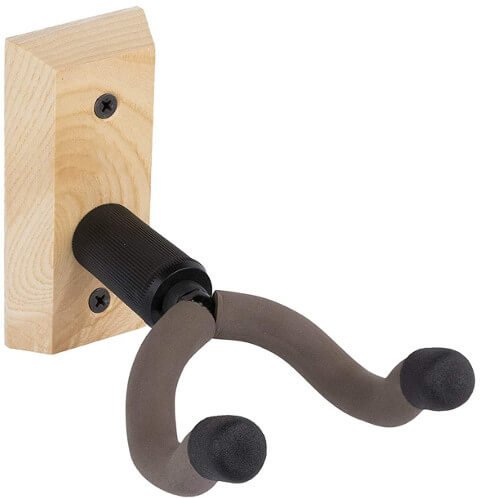
The guitar hanger that is used most often is the simple V-shaped angled claw style. This hanger is designed to be mounted to the wall in line with a stud.
The screw holes used to mount it run vertically so that both can bite into the stud. This will give the hanger the strength to hold the guitar without ever falling off the wall.
The guitar is then held by the bottom of the headstock where it meets the neck. The hooks are slightly angled so that they cannot slip forward and off of the hanger. And there is usually no contact with the tuning machines.
The guitar can remain on it for a longer period as long as the room humidity is maintained in the suggested range. And that the instrument is not in direct sunlight, as this can harm or dull the finish.
Some people say that hanging the guitar this way can harm it. But this simply is not true. The weight of the guitar is nothing compared to the tension the strings put on the neck. So hanging it from the wall this way is very safe. Just be sure not to buy cheap hangers of this style.
Some are poorly crafted and this can put your guitar in harm’s way. When buying them, get the one with the best quality, even if they cost a few more dollars.
Locking Hangers
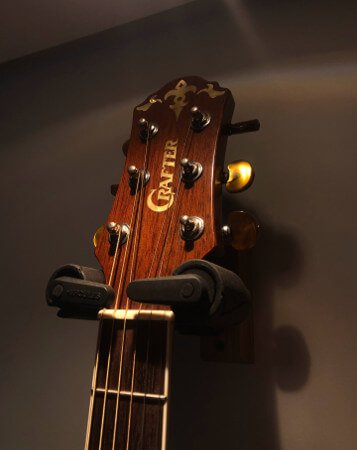
The locking version is similar to the standard version. Except for the mechanism that locks the guitar into the hanger. These are a better version as when the weight of the guitar is put onto the hanger, 2 tabs move in front of the neck.
This then locks the instrument in, preventing it from being removed until it’s lifted.
You will see these being used at music stores or conventions like NAMM. This is because they are super effective. Even if the guitar is bumped, it’s quite unlikely that it will fall.
So if you are putting yours on the wall in a small room where they could get bumped, these are a better solution. So is it bad to hang guitars on the wall? Not when they are locked in place!
Display Rack
The display rack hangers are a bit different. This configuration allows you to angle the guitar on the wall if you want it to look more like a display.
These are a 2-piece system that holds the body of the guitar with one and the neck with the other piece. It allows you to put them at a 45-degree angle, which can also be handy in a small room.
This would allow you to essentially put one guitar over the other. Instead of hanging them vertically like the other two systems. If you’re low on wall space, you may want to check this system out.
Guitar Display Cases
We also wanted to mention the guitar display cases. These are boxes made to hold them in a display case that can be hung from the wall.
These are used to showcase the instruments and are great for rare finds, or vintage models with a nitro finish. They are relatively cheap and are a great way to keep guitars protected but be seen on the wall.
The display cases normally come with a glass door that works as a cover to protect the instrument. If you want to play the guitar, then it’s as simple as opening the front door and taking it out.
Steps To Mount Guitar Hangers to a Wall
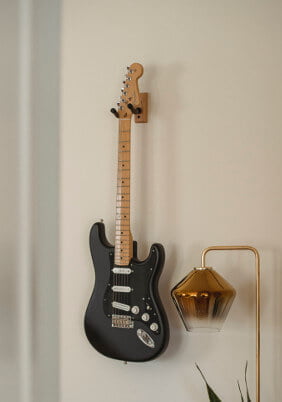
Once you have decided to hang your guitars from the wall, it’s time to start planning. First, you will need some tools to do this job:
- Phillips screwdriver or drill bit
- Basic or laser level
- Stud finder
- Tape Measure
- Drill and bits
- Masonry Bit (for brick walls)
- Pencil
- Painters Tape
These are basic tools that are easy to get or may already be in your garage. Then, once you have the tools sorted, it’s time to decide on how many guitars you will hang and the method you want to use. For this example, we will be using the locking hangers.
You will also want to make sure to have all the supplies you will need. Things like hangers, screws, and anchor inserts.
Step 1: Select Location on the Wall
First, begin by selecting an area on the wall to hang your guitar. Choose an area that will not have the instrument get bumped frequently or in direct sunlight. Then decide on the height to hang it.
You want the guitar to be easy to hang. Not too high to prevent any issues with loading and unloading it from the hanger. But high enough to look good and be functional and still able to put a guitar amp under it.
If you have more than one guitar, be sure to plan out how you want them to hang. Perhaps they are equally spaced or even staggered. Plan this out ahead of time and make sure you have enough hangers and fasteners.
Step 2: Locate a Stud In The Wall
Once you have planned out how you want to hang them, proceed to locate the studs in the wall using the finder. Most houses have 16″ between studs, so keep this in mind when deciding on spacing.
This should be plenty of room between most guitars, but measure them all to make sure. If not, staggering them in height could help.
Once you have found studs, mark them using painter’s tape and a pencil. At this point, it’s okay to rough them in. If you like, find a reference point off the ceiling or floor to determine the height.
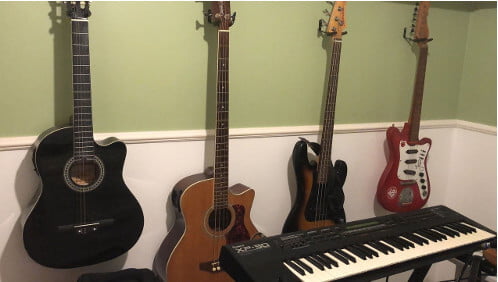
Step 3: Mark Height and Position
Now that you have found all studs, we want to make sure all our measurements are accurate. If you have more than one guitar to hang, use your laser level and get the height right between them. A laser level here can be very handy. The height will be the top of the wooden block on the hanger.
If you don’t have a laser type and are not too concerned, you can simply use a bubble level and a measuring tape. Take your time and use the floor or ceiling as a reference point. Then use the level and possibly a long flat straight edge to go from one hanger position to the other.
Mark the height at the point of each stud as you go. Then, recheck the stud positions. You want to make sure you have marked as close to the center as possible. Once completed, you should have painter’s tape at each position. With both height and stud center.
Just make sure the stud center mark is quite long, at least the length of the block on the hangers.
Step 4: Drill Holes
You are now ready to mount the hangers! Normally the screw holes in the block are a bit small, so putting a pencil into them to mark the wall is not possible.
The best way to go about this is to put a small bit into your drill and use this to mark out holes.
We will make small pilot holes as we go along. Or, if this seems too bulky, you can use a small drill bit and turn it in the hole once the hanger is in place. This will mark the wall with a small center position that will help with drilling later.
Take a hanger and put it on the wall over the stud center. Line the stud center mark up to the screw holes in the block. Then set the height by having the line you made match up to the top of the block. Your hanger is now in position.
You can take a level and put it on the side of the block, just to verify it is in fact right. Then proceed to run a drill bit into the holes and make a mark on the wall. Do this for all hangers.
Then, once done, proceed to drill holes for each hole you marked. Use a drill bit that is slightly bigger than the screws you have to mount the hangers.
Step 5: Mount the Hangers
Next, proceed to mount the hangers to the wall by using the screws. Insert a screw in each hole of the hanger and then drive them through the block into the stud in the wall.
Do this for all of them, and you’re done! Just make sure not to overtighten the screws! Recheck the level of each one if you desire, and tweak it if necessary.
You are now ready to test a guitar in a hanger. Make sure they all look sturdy now that they have been assembled and mounted to the wall. Is it bad to hang guitars on the wall? Not when the installation is done right!

FAQs
Is it Better to Hang a Guitar or Keep it in a Case?
Hanging a guitar can be plenty safe if the proper precautions are taken. But it’s still best to store it in a case for ultimate protection.
This is because it is physically protected and cannot fall when it’s in a case. It’s also possible to keep the humidity and temperature levels just right for the guitar.
Is it OK to Hang Guitars by the Neck?
Some people feel that this puts stress on the neck which is not necessary or good for the instrument. But the opposite is true.
The neck is always under tension because of the strings, which are far greater than hanging it. The strings also add support because of the tension they are under. It’s perfectly fine to hang them this way.
How Do You Store a Guitar Long Term?
If you don’t plan on using a guitar for a while, it’s ok to have it sit on a hanger on the wall. Many people put them up as decoration and never touch them.
Granted the environment is right for the guitar, but it can sit like this long term. Even expensive instruments are hung from the wall as a display.

